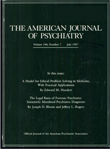The clinical significance of command hallucinations
Abstract
Patients with command hallucinations (voices ordering particular acts, often violent or destructive ones) are commonly assumed to be at high risk for dangerous behavior. The authors reviewed 789 consecutive inpatient admissions. Of 151 patients with auditory hallucinations, 58 (38.4%) heard commands. The presence of auditory hallucinations was significantly associated with diagnosis, demographic variables, and use of maximal observation and seclusion. However, patients with command hallucinations were not significantly different from patients without commands on demographic and behavioral variables, including suicidal ideation or behavior and assaultiveness. These findings suggest that command hallucinations alone may not imply greater risk for acute, life- threatening behavior.
Access content
To read the fulltext, please use one of the options below to sign in or purchase access.- Personal login
- Institutional Login
- Sign in via OpenAthens
- Register for access
-
Please login/register if you wish to pair your device and check access availability.
Not a subscriber?
PsychiatryOnline subscription options offer access to the DSM-5 library, books, journals, CME, and patient resources. This all-in-one virtual library provides psychiatrists and mental health professionals with key resources for diagnosis, treatment, research, and professional development.
Need more help? PsychiatryOnline Customer Service may be reached by emailing [email protected] or by calling 800-368-5777 (in the U.S.) or 703-907-7322 (outside the U.S.).



